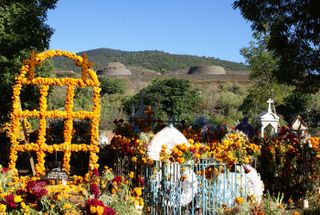
Graves decorated for Noche de los Muertos (Night of the Dead) in the Tzintzuntzan, Michoacán panteón (cemetery). These recent graves lie within easy sight of the yácatas (Purépecha pyramids, mid-center in the photograph) just across the road. The yácatas were formerly both a priestly burial site and the site of ancient Purépecha religious ceremonies.

The packed-earth paths among the graves at the cemetery in Tzintzuntzan wind through old trees and dappled sunshine.
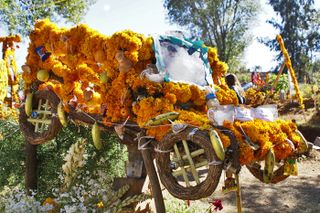
This little car, decorated with cempasúchil (marigold) flowers, fruits, and pan de muertos (bread of the dead) in the shape of human figures, is the cemetery ofrenda
(altar, or offering) for a baby born in October and dead in November
2005. Tiny white baby shoes are on the car's hood, along with a baby
bottle. Click on any photo to enlarge it.
The faithful Purépecha believe that the angelitos,
the dead children, are the first of the departed who come to re-visit
their loved ones each year during the day of November 1, arriving at
noon. Their parents take an ofrenda (offering) of fruit,
candies, and wooden toys to the children's graves and invite the little
ones to come and eat. Late in the night, the godfather of a dead child
goes to the cemetery with an arco (arch) made of cempasúchil (marigolds). At home, the parents have already prepared beautiful altars to honor the memory and spirits of their children.
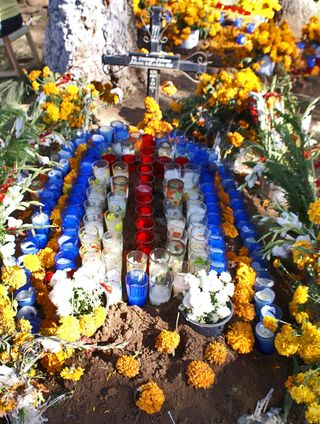
Cempasúchiles, gladiolas, and candles adorn this grave. The cross is made of red veladoras (candles in holders) in a framework of blue and white.
Each
year, late in the night of November 1, the spirits of deceased adults
make their way back to this earthly plane to visit their relatives. The
living relatives, bearing food, bright golden flowers, strong drink,
and other favorites of the dead, file into Purépecha cemeteries to
commune with those who have gone before. The assembled lay out
blankets, unfold chairs, bring out plastic cups, cartons of beer, a
bottle of tequila, and assorted food for their own consumption as they
settle in for the long, cold night of vigil.
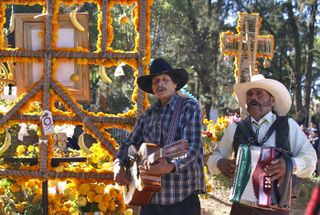
A band or two or three often wander about in the cemetery, hired for a song or two or three to entertain the living and the dead.
Copal
incense burns, calling the souls of the dead home. Candles, hundreds
and hundreds of candles, flicker on and around the graves, showing the
way home to the wandering spirits. Food–especially corn tamales and churipo,
a beef soup for festivals–and other personal gifts to the 'visitors'
show that the spirits are still valued members of their community.
Special pan de muertos (bread of the dead) in the form of human
bodies represents the relationship between the living and the dead.
Fruits, including bananas, oranges, and limas, are hung on the ofrendas de cempasúchil to represent the relationship between nature and human beings.
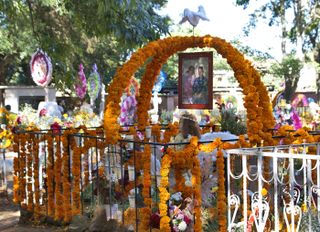
This elaborate bóveda de cempasúchil
( marigold arch) hung with an old family photograph and topped by a
feather dove (the symbol of the Holy Spirit) decorates a family grave.
Under the photograph, an angel stands vigil.
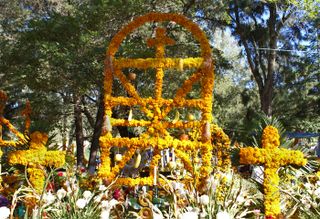
Marigolds
are used as symbols for their yellow color, which resembles the gold
that was used as decoration for the ancient grand festivals. The
flowers were used to adorn the visitor in the form of crowns or
necklaces. Today, the belief is that the ofrendas de cempasúchil (marigold arches) aid the visiting spirits to identify their homes. Cempasúchil petals are also strewn over the bare earth mounds of the graves.
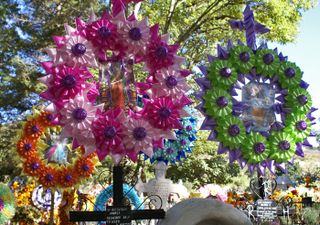
These modern coronas
(wreaths) are made of ribbons and plastic, much more durable than fresh
flowers. The brilliant colors eventually fade over the course of a
year, but the wreaths will stay up till next October.
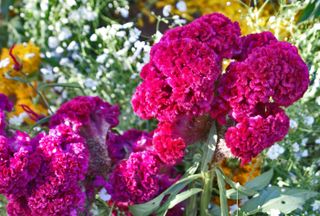
Cempasúchiles, pata de león (lion's paw, as cockscomb is known in this part of Michoacán), freshly cut gladiola, nube (baby's breath) and just-in-season wild orchids from the mountains are the flowers most commonly used on Tzintzuntzan's graves.
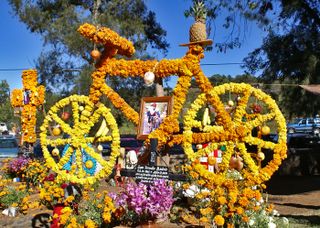
My favorite ofrenda of 2009: a terrific full-size bicycle made of cempasúchiles,
decorated with fruit–and with pineapple on the seat! The flowers at
the base of the grave marker are wild orchids. This style figural ofrenda is very unusual.
Looking for a tailored-to-your-interests specialized tour in Mexico? Click here: Tours.
Leave a Reply to Shannon Casey Cancel reply